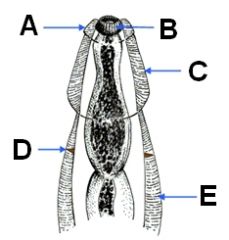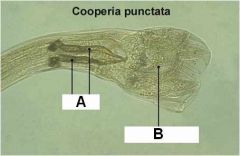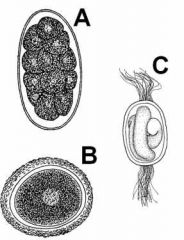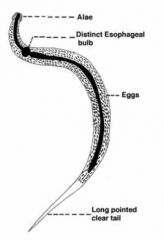![]()
![]()
![]()
Use LEFT and RIGHT arrow keys to navigate between flashcards;
Use UP and DOWN arrow keys to flip the card;
H to show hint;
A reads text to speech;
160 Cards in this Set
- Front
- Back
|
What are the major groups of parasites (hint...there are 3)? |
Worms (helminths)
Protozoa Arthropods |
|
|
What are the major parasitic helminth groups of veterinary interest?
|
Nematodes (roundworms)
Digenes (flukes) Cestodes (tapeworms) Also acanthocephala, pentastomes |
|
|
A relationship in which one of the participants either harms or lives at the expense of the other is...
|
...my first marriage! Wait...I'm in my first marriage! Seriously, it's PARASITISM
|
|
|
A relationship in which one of the participants benefits without affecting the other is...
|
...commensalism
|
|
|
A relationship which is mutually beneficial to both participants is known as... |
...mutualism
|
|
|
What factors distinguish a parasite from a predator?
|
Size and time of association
(parasites are usually much smaller than their host and have a longer association with them) |
|
|
An organism that can exist on its own or through parasitism is known as a(n) ___________ parasite.
|
facultative parasite
|
|
|
An organism that can only exist via parasitism is known as a(n) _________________ parasite.
|
obligate parasite
|
|
|
A host in which a parasite is incapable of completing its life cycle is a(n) ___________ host.
|
Aberrant host
|
|
|
An abnormal host in which a parasite can complete its development is a(n) _____________ host.
|
Accidental (incidental) host
|
|
|
T or F:
Aberrant hosts are always dead-end hosts. |
True.
|
|
|
T or F:
Aberrant hosts are not dead-end hosts. |
False! They can be dead-end (parasite can complete development but fails to find a portal of exit)
|
|
|
Which host contains the sexual stages of a parasite?
|
Definitive host
|
|
|
T or F:
Paratenic hosts are synonymous with intermediate hosts. |
False! Parasite development occurs within an intermediate host but NO DEVELOPMENT occurs in a paratenic host
|
|
|
Which life cycle strategy describes a parasite that only requires one host to complete its life cycle?
|
Direct (monoxenous) parasite
|
|
|
In which host type does no parasitic development occur?
|
Paratenic (transport) hosts
|
|
|
Which life cycle strategy describes a parasite that requires more than one host to complete its life cycle?
|
Indirect (heteroxenous) parasite |
|
|
Latin for egg layer is...
Latin for live bearers is... |
oviparous
viviparous |
|
|
Embryos in "eggs" with no maternal nutrition; larvae born alive describes...
|
...ovoviviparity
|
|
|
a parasite of a parasite is called...
|
...a hyperparasite (I tried to find a witty answer for this one but came up short)
|
|
|
A parasite that can have many definitive hosts has ________ host specificity. Conversely, a parasite with only one definitive host has _______ host specificity.
|
Broad/narrow host specificity
|
|
|
A wild animal that harbors parasitic infection before transmission to domestic animals is a __________ host.
|
Reservoir host
|
|
|
Resistance to parasitic infection that is established after an acute infection has become chronic is known as_____________.
|
Premunition
|
|
|
What is another name for developmental arrest?
|
Hypobiosis
|
|
|
What is a nematode family that undergoes hypobiosis? Why would it do such a thing?
|
Strongyles
strategy - "overwinters" as L4 in host; allows for lots of infective larvae in the spring (lambing time)! |
|
|
T or F:
Nematodes are second only to the insects in terms of diversity. |
True, yo!
|
|
|
Generically characterize nematodes in terms of their:
sexes morphological elaboration "skeleton" |
dioceious sexes
morphological elaboration around openings hydrostatic skeleton |
|

Which letter(s) denote the Leaf Crown?
Which denote the Alae? How 'bout the vesicles? |

Leaf Crown - B
Alae - E Cephalic Vesicle - A Cervical Vesicle - C |
|
|
What is nematode-induced tissue damage proportional to (and it is NOT the number of parasites)?
|
The mouth size
|
|

What are these doodads? Is this a male or female?
|

Male!
A = spicules B = copulatory bursa |
|
|
What helmenthic GI structure is often used as an initial screener for identification?
|
Esophagus shape
|
|

Let's do some matching...
Embryonated egg Unembryonated egg Embryonating egg |

Embryonated egg - C
Unembryonated egg - B Embryonating egg - A |
|
|
Fill in the blanks for nematode development:
egg-->__-->__-->__-->__-->adult |
egg>L1>L2>L->L3>L4>adult
|
|
|
Another name for a nematode molt is...
What is shed in the molt? |
ecdysis
Cuticle is shed |
|
|
T or F:
Adult strongyles cause the most damage to the host. |
False! Larval migrans (L3/L4) do the most damage.
|
|
|
What are three signs seen in a helminth infection?
|
Impaired weight gain
Impaired food conversion Reduced fitness |
|
|
What are the 6 orders of nematoda that are of veterinary importance?
|
Rhabditida
Strongylida Ascaridida Oxyurida Spirurida Enoplodida |
|
|
Which group are the pinworms in?
|
Oxyurids
|
|
|
Oxyurids are also known as...
|
pinworms!
|
|
|
What order do the hookworms and hairworms share?
|
Strongylida
|
|
|
Which worms are in the order Strongylida (there are 3 main groups)?
|
Hairworms (trichostrongyloidea)
Hookworms (ancylostomatidae) Strongyles (strongylidae) |
|
|
In which order are the lungworms found?
|
Strongylida
|
|
|
Big-ass roundworms are better known as...
|
Ascarids
|
|
|
Which nematode order uses invertebrates as vectors and intermediate hosts?
|
Spirurida (spirurids and filarial worms)
|
|
|
Heartworms are found within which nematode order?
|
Spirurida
|
|
|
Aw snap! Grampa got trichinosis! Tell him which nematode order trichinella is found in?
|
Enoplodida
|
|

What kind of nematode is depicted here?
|

Pinworm (Oxyuridae)
|
|
|
Which region of the GI tract do oxyurids (pinworms) inhabit?
|
Lower intestine
|
|
|
What is unique about pinworms?
|
Only nematode that migrates out of the host to lay eggs (lays them around uranus); also pretty much the ONLY nematode with the entire life cycle within the GI tract
|
|
|
How long does it take eggs from Oxyuris equi to become infective? How long is the prepatency time?
|
4-5d before eggs are embryonate and infectious
Prepatency time (time b4 adults lay eggs) is ~5months |
|
|
How is Oxyuris equi treated?
|
Ivermectin or pyrantel
|
|
|
Besides horses, what are other important hosts for pinworm infection?
|
Rabbits
lab rodents |
|

ID this nematode, fool!
|

Oxyurid (pin worm)
Check the esophageal bulb and long clear tail |
|
|
What is the MOST IMPORTANT genus in Trichostrongylidae (hair worms)? What do they infect in the NW?
|
Haemonchus infects sheep, cattle, goats, and llamas
|
|
|
Which nematode family (not order) is responsible for parasitic gastroenteritis?
|
Hairworms (trichostrongylidae)
|
|
|
What are some characteristics of hairworms (trichostrongylidae)?
|
Small
Absent (or reduced) leaf crowns Absent (or reduced) buccal capsule Well-developed bursa |
|
|
Which larval stage is ingested in the hairworm (trichostrongylid) life cycle?
|
L3
|
|
|
T or F:
Trichostrongylid (hairworm) hyperinfection is not an issue in free-range cattle. |
True! Confinement causes hyperinfection.
|
|
|
The "spring rise" or increased concentration of fecal eggs per gram is an example of what parasite strategy?
|
Hypobiosis
|
|
|
Which genera of trichostrongylidae are the most important to veterinary medicine?
|
Haemonchus
Ostertagia Trichostrongylus Nematodirus |
|
|
Do barber pole worms (Haemonchus spp.) have a long or short prepatency period?
|
Short (2-3 wks)
|
|
|
About how long do Haemonchus larvae remain infective in the pasture?
|
Up to 6 months
|
|
|
Where do Haemonchus infections usually manifest in ruminants?
|
Abomasum
|
|
|
What structures give Haemonchus the "barber pole" appearance?
|
White gonads twisted around blood-containing gut
|
|
|
How do Haemonchus (barber pole worms) cause so much tissue damage (hint - it is something to do with their mouth)?
|
SMALL mouth but has a lancet that slices away tissue
|
|
|
What are some signs of trichostrongyle infection?
|
Edema (bottlejaw)
Anemia Lethargy Weight loss and death |
|
|
What is the parasitic "wonder drug"?
|
Ivermectin
|
|
|
What are some management practices that will cause parasite resistance?
|
Treating all animals at once
Treating frequently Underdosing Treating when few larvae on pasture Treating then moving to clean pasture |
|
|
What are two systems used to prevent parasite resistance?
|
Drenchrite system
FAMACHA system (form of selective treatment) |
|
|
T or F:
Treating the 33% most affected individuals of the herd is more effective than treating the entire herd for parasites. |
True!
Since 20-30% of the animals harbor most of the worms, this kills the virulent worms AND prevents resistance! |
|
|
T or F:
Killing organisms in refugia is an important aspect of reducing antihelmenthic resistance. |
False!
Organisms in refugia shouldn't be killed as they increase genetic diversity and reduce resistance. |
|
|
How do sheep become infected with Haemonchus?
|
Eat larvae with grass
|
|
|
What is the most important strongyle of cattle?
|
Ostertagia ostertagia
|
|
|
What is the most important strongyle of sheep and goats?
|
Teladorsagia spp.
|
|
|
How does Ostertagia ostertagia cause disease in cattle?
|
Encysted larvae cause disease (tissue reactions to worm = hyperplastic response and inflammation)
|
|
|
Why does Ostertagia cause disease in young and adult cattle (or why/when are young and adult cattle susceptible to disease)?
|
Young - immunological naive
Adult - if experiencing stress (pregnancy, shipping, etc), hypobiotic larvae emerge |
|
|
What is the proportion of the parasite population that is not selected by drug treatment?
|
In refuga population
|
|
|
T or F:
Trichostrongylus spp.only infect the small intestine. |
False!
MOST infect the small intestine but T. axei infects the abomasum. |
|
|
Which of the Trichostrongylus spp. co-infects sheep and cattle? Where does the infection occur?
|
T. axei; infects the abomasum
|
|
|
Which of the trichostrongyles has a ridiculously large egg?
|
Nematodirus
|
|
|
What is unique about Nematodirus among the rest of the trichostrongyles?
|
Nematodirus has a ginormous egg; hatches as an L3
|
|
|
A state of resistance to infection that is established after an acute parasitic infection has become chronic and persists throughout the life of the organism is known as....
|
...PREMUNITION
|
|
|
Which family of Strongylida comprises the hookworms?
|
Ancylostomatidae
|
|
|
Which region of the GI to hookworms parasitize? What are common hosts?
|
small intestine of dogs, cats, sheep, cattle, humans
|
|
|
What are some morphological characteristics of ancylostomitidae?
|
HOOKED DORSALLY
Big teeth! Presence of spicules on male posterior No leaf crowns |
|
|
What is the key genus of the hookworms?
|
Ancylostoma
|
|
|
Which hookworms are key parasites of dogs? Of cats?
|
Ancylostoma caninum (dogs)
Uncinaria stenocephala (cats and dogs) A. tubaeformae (cats) |
|
|
Which hookworms are key parasites of sheep? Of cattle?
|
Bunostonum trigonocephalum (sheep)
B. phlebotomum (cattle) |
|
|
What are some transmission strategies used by hookworms?
|
transmammary
transplacental transdermal oral ingestion (direct and by paratenic host) |
|
|
Regarding Ancylostoma caninum, what is the route taken by L3 larvae after transdermal transmission?
|
skin > circulation > lungs > alveoli > trachea > swallowed by host > to GI
|
|
|
T or F:
Ancylostoma caninum undergo arrested development in the muscle as L4 larvae. |
False! They arrest at L3
|
|
|
What pathologies are common with Ancylostomatid infection?
|
Anemia
weakness, poor growth Malena emaciation pale gums dull haircoat death |
|
|
What is the treatment protocol for hookworm infections in dogs?
|
Ivermectin + pyrantel
|
|
|
Which of the two common hookworms of dogs is the most pathogenic? Why is the other one not as pathogenic?
|
Ancylostoma caninum (most pathogenic)
Uncinaria stenocephala (least pathogenic due to lack of teeth; does less damage) |
|
|
T or F:
Infection with Uncinaria stenocephala frequently occurs transdermally. |
False! It is usually oral!
|
|
|
T or F:
Infection by Bunostomum spp. (hookworm) in sheep and cattle frequently occurs transdermally. |
True! Rarely orally
|
|
|
Which family of Strongylida comprises the "large strongyles"?
|
Family Strongylidae
|
|
|
What are the 3 most important species of large strongyles in horses?
|
Strongylus vulgaris
S. endatus S. equinus |
|
|
T or F:
Strongylus vulgaris has similarities to Nematodirus in that it is ingested as an L3. |
True!
Nearly all Strongylids are ingested at the L3 stage. However, Nematodirus HATCHES as L3 while S. vulgaris hatches as L1. |
|
|
Describe the migration of S. vulgaris after ingestion.
|
1. Ingestion
2. Penetrates duodenal submucosal arteries and molts to L4 3. L4 migrate to cranial mesenteric a. 4. develop 3-4 mos. into L5 5. return to intestinal wall via arteries (cecum and large int) 6. nodules form and rupture, releasing adults into intestinal lumen |
|
|
T or F:
Strongylus vulgaris has a very short prepatency period. |
FALSE
|
|
|
Contrast Strongylus vulgaris and S. edentatus in terms of migration of L3.
|
S. vulgaris - L3 migrates to cranial mesenteric a.
S. edentatus - L3 migrates to liver |
|
|
What circulatory lesion is closely associated with Strongylus vulgaris?
|
Verminous arteritis
|
|
|
Which group is known as the "small strongyles"?
|
Cyathostomes
|
|
|
What are the main morphological differences between the large and small strongyles?
|
Large strongyles have large, well developed buccal capsules and attach to mucosa
Small strongyles have smaller buccal capsules and do not attach to the mucosa |
|
|
What is (currently) the most important internal parasite of horses?
|
Chathostomes (small strongyles of the horse)
|
|
|
Compare/contrast the general life cycle of small and large strongyles in the horse.
|
Both are released as eggs, hatch into L1 and are ingested as L3. However, small strongyles don't migrate farther than the wall of the intestine.
|
|
|
What event creates the clinical signs associated with cyathostomatitis?
|
simultaneous emergence of encysted L4 from the intestinal wall
|
|
|
Which has the longer prepatency, small or large strongyles?
|
large strongyles
|
|
|
When are the highest periods of risk from cyathostomatitis?
|
spring and fall
|
|
|
When should animals be treated to prevent heavy pasture contamination of cyathostomes?
|
early in the grazing season (spring and early summer)
|
|
|
T or F:
Small strongyles and large strongyles can both be effectively diagnosed by fecal egg counts. |
False!
Large strongyles can but not small due to encysted (hypobiotic) larvae |
|
|
What can be used to treat small strongyles?
|
Not a lot:
Fenbendazole is best but has resistance issues Moxidectin works OK Vitamin I and Pyrantel - don't even bother! |
|
|
Which group of strongyles infects cattle, sheep, and goats in the tropics?
|
Oesophagostomum spp.
|
|
|
Which worm is the "nodule worm"?
|
Oesophagostomum
|
|
|
What is the superior technique for counting trichostrongylid eggs?
|
McMaster's technique
|
|
|
Which is also known as a rhabditid? Strongyles or strongyloids?
|
Strongyloids
|
|
|
T or F:
Nearly all rhabditids are parasitic |
False! Only one genus is! Strongyloides
|
|
|
What is an interesting feature of the strongyloid life cycle?
|
It can be entirely free-living, entirely parasitic, or a mixture of the two
|
|
|
T or F:
All strongyloid (rhabditid) larvae are capable of transdermal penetration. |
False.
Only the filariform larvae |
|
|
T or F:
Both Ancylostomes (hookworms) and Strongyloids (rhabditids) undergo a tracheal migration after transdermal penetration. |
True!
|
|
|
T or F:
The only Ancylostome (hookworm) adults found in the intestinal lumen are female. |
False!
This describes the Strongyloids (rhabditids) |
|
|
What are the two main ways that rhabditids (strongyloids) infect their host?
|
Transdermal penetration
Autoinfection (larval penetration of intestinal mucosa after hatching in lumen) |
|
|
What are the four major species of rhabditids and what species does each infect?
|
Strongyloides westeri – horses
S. stercoralis – dogs, humans S. ransomi – swine S. papillosus – ruminants, rabbits |
|
|
Which antihelmenthics are effective against Strongyloides (rhabditids)?
|
Vitamin I (Ivermectin)
|
|
|
Why are lungworms called lungworms?
|
If you have to ask, you'll never know. DUH! Because the adults infect the LUNGS!
|
|
|
T or F:
Lungworms are a superfamily of order Strongylida. |
True
|
|
|
What is the major lungworm of cattle? Which larval form is ingested?
|
Dictyocaulus viviparus; L3 is ingested
|
|
|
How are Dictyocaulus larvae spread?
|
Via pilobolus fungi
|
|
|
T or F:
Cattle lungworm infection is diagnosed by identification of eggs in feces. |
False!
Larvae (L1) are found in the feces; need to use Baermann funnel test |
|
|
How is Dictyocaulus treated?
|
Most antihelmenthics work well
|
|
|
How does the life cycle of the sheep lungworm Muellerius capillaries differ from dictyocaulus?
|
Uses slugs/snails as intermediate host
|
|
|
How does the life cycle of the swine lungworm Metastrongylus differ from dictyocaulus?
|
Uses earthworms as intermediate host
|
|
|
T or F:
Cats commonly contract lungworms by eating the intermediate hosts of Aelurostrongylus abstrusus. |
False!
Slugs/snails are the intermediate hosts and mice/voles are the PARATENIC hosts |
|
|
What is unique about the life cycle the dog lungworm, Filaroides?
|
L1 larvae are INFECTIVE
|
|
|
What are the hosts of Oesophagostomum spp? (circle the letter of your choice)
A .Cattle and sheep B. Cattle, sheep, pigs C. Cattle only D. Sheep only |
B. Cattle, sheep, pigs (also goats)
|
|
|
What stage/s are parasitic in Strongyloides spp. infections?
i.e., what stages would you find inside/infecting the host? |
All stages except that adult is only female
|
|
|
What is the cause of cutaneous larval migrans in humans?
|
Hookworm
|
|
|
What is premonition?
|
When an acutely parasitized organism develops a degree of resistance after the parasitism becomes chronic
|
|
|
What is the diagnostic stage of lung worms and where would you find this stage?
|
Baermann technique, fecal float, tracheal wash/sputum
has eggs or L1 |
|
|
What are some morphological characteristics of Ascaridae?
|
3 lips
large and white roundworms no bursa on males they make your butt look ugly |
|
|
T or F:
Ascarids have infectious eggs. |
True! They hatch as L2 or L3 after egg is ingested.
|
|
|
Why are ascarids tough to get rid of?
|
Sticky eggs
Eggs are tough to kill (thick shell) Larvae develop to L2 or L3 in eggs |
|
|
T or F:
Ascarids undergo tracheal migration. |
True! Even though they don't penetrate the skin (a la Rhabditids or Ancylostomids), they undergo tracheal migration after penetrating the intestinal mucosa
|
|
|
What lesions are caused by Ascirus suum that will condemn pig livers? How are these lesions formed?
|
Milk spot liver from ascarid larval migrans
|
|
|
T or F:
Normal ascarid infection does not manifest with anemia. |
True! Ascarids eat the host food, not the host!
|
|
|
What is the ascarid that infects humans? Horses?
|
Ascaris lumbroides
A. equorum |
|
|
T or F:
Older horses are immune to Ascaris infection. |
True! Once they are >2yo, they have immunity.
|
|
|
What are some management strategies that can prevent ascarid infection in foals?
|
pick up manure
feed off the ground use ivermectin/pyrantel for adult roundworms deworm all horses stabled together at once (???) |
|
|
Ascarid infection of which domestic animal may have acetone (fruity) breath as a sign?
|
Cattle infected by Toxocara vitulorum
|
|
|
Which ascarid is a zoonotic agent? How is it most likely transmitted?
|
Bayliascaris procyon (raccoon ascarid) transmitted via direct infection of dogs
|
|
|
T or F:
Toxascaris leonina exhibits no tracheal migration in either dogs or cats. |
True!
Larvae are eaten either directly or within paratenic host (rodent), undergo period of histotrophy, then enter intestinal lumen. |
|
|
Yuk! Your damn cat puked a worm on my shoes! What kind of worm is it likely to be?
|
Toxocara cati
Frequently vomited; have arrowhead cephalic region |
|
|
These ascarids are parasites of marine mammals and birds...
|
Survey says....
ANISAKIDAE |
|
|
What are the intermediate hosts of anisakids? What is the definitive host? What is a dead-end host?
|
Intermediate - crustaceans and fish
Definitive - sea mammals and birds Dead-end - Humans |
|
|
what is prevalence? |
% infected |
|
|
what is incidence? |
change in infection over given time |
|
|
what is density? |
number of parasites/total hosts |
|
|
what is intensity? |
number of infected animals |
|
|
what is abundance? |
number of parasite/host, includes uninfected |

